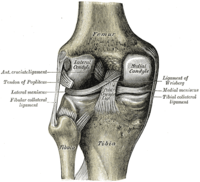
Photo from wikipedia
Background: In a small proportion of cases, spontaneous osteonecrosis of the knee (SONK) involves the medial tibial plateau (MT). Here, we introduced the clinical characteristics of spontaneous osteonecrosis of the… Click to show full abstract
Background: In a small proportion of cases, spontaneous osteonecrosis of the knee (SONK) involves the medial tibial plateau (MT). Here, we introduced the clinical characteristics of spontaneous osteonecrosis of the MT and unicompartmental knee arthroplasty (UKA) as the favorable treatment for this situation based on a retrospective case study. Methods: Patients with spontaneous osteonecrosis of the MT, confirmed by magnetic resonance imaging (MRI) at Guangdong Provincial Hospital of Chinese Medicine (China) from March 2015 to June 2016, were included as a case serial and analyzed retrospectively. All patients underwent Oxford Medial UKA. The characteristics of their lesions, corresponding treatment, and results of follow-up were presented. The lesion scores and grade were determined according to the criteria of Ficat and Arlet. Results: In total, 22 patients (5 men, 17 women; mean age, 64.1 years) with spontaneous osteonecrosis of the MT were analyzed. The lesion stages assessment showed that 3 (14%) were Stage II, 10 (45%) were Stage III, 7 (32%) were Stage IV, and 2 (9%) were Stage V. In the sagittal plane, 7 (32%) were in the anterior region (MTa) and 15 (68%) were central (MTc). The lesion volume averaged 2.24 ± 0.79 cm3 (range: 1.57–3.08 cm3). Seventeen patients (77%) had Level III posterior medial meniscus root tears (MMRTs). All the patients underwent UKA. Average follow-up was 30.0 ± 6.4 months with a range of 23.0–38.0 months. The visual analog scale score was 7.78 ± 0.67 before surgery while decreased to 2.22 ± 1.09 at the final follow-up (P < 0.001). The Hospital for Special Surgery scores of pre-/post-surgery were 65.67 ± 5.45 and 84.10 ± 4.20, respectively (P < 0.001). Conclusions: SONK often occurs in the anterior and central tibial plateau due to abnormal stresses. Most of the patients had Level III posterior medial meniscus root tears. MRI is recommended for suspected cases to identify SONK at an early stage. The use of the Oxford Medial UKA for SONK of the MT is reliable both immediately and at follow-up.
Journal Title: Chinese Medical Journal
Year Published: 2018
Link to full text (if available)
Share on Social Media: Sign Up to like & get
recommendations!